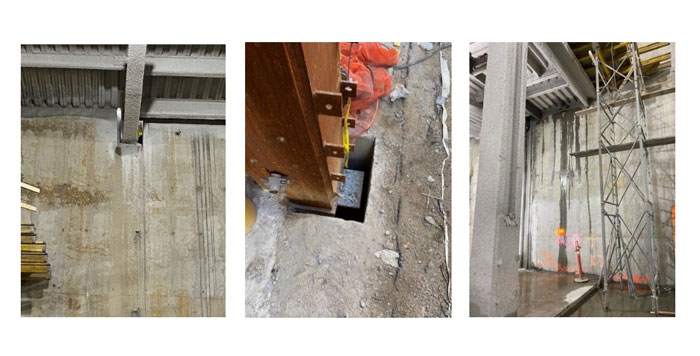Before starting a water remediation program, a careful investigation of foundation leaks should be performed. The following provides our recommended best practices for foundation leak investigation while a building is still under construction.
1. Prior to any attempts to repair any apparent areas of water infiltration, the building must be completely dried in. This includes the below grade to above grade tie in, exterior above grade envelope, as well as the roof.
2. Walk the perimeter of the building and identify any obvious areas suspected of water infiltration, i.e., lack of roofing, openings in above grade walls, foundation walls, incomplete waterproofing, etc. The photos below show examples of openings within and at the top of the foundation walls that allow driving rain and water from other sources to enter the foundation and collect on the foundation floors. All voids in the exterior building envelope should be sealed in a watertight manner.
3. Ensure that the building is watertight at the top and above the foundation, with properly completed details to tie-in the foundation waterproofing system to the above grade horizontal deck waterproofing system and or air and water barrier system on the above grade walls. Pay particular attention to the roof, exterior walls, and all waterproofing details to ensure they are complete and watertight.
4. When the above sources of infiltration have been eliminated, any remaining areas of water intrusion can be investigated. If the building has a temporary dewatering system that is used only during construction, then the investigation should not start until the dewatering system is turned off to ensure that areas of water intrusion (if any) are results of ground water. Use fans or other methods to circulate air in the foundation and dry any wet areas. The source of water may not be evident, and water movement can be very deceptive. For example, water may be entering through a defect in the waterproofing system towards the top of the wall, traveling along cracks in the foundation wall, and entering the building towards the bottom of the wall. Tracing the source is important and requires skill, patience, and expertise.
5. GCP and DE NEEF® has a team of expert Field Technical Service Managers that have experience with leak investigation and leak repair and should be consulted. They can advise on the order of repair.
6. DE NEEF® Chemical Injection Grouts have been successfully used to address leaks in foundations. This team is available to provide site visits to help investigate a leak. Please consult with your local GCP Representative to set up a site visit or go our website at www.gcpat.com to locate a GCP Representative.
gcpat.com | North America Customer Service: +1 (877) 423 6491
GCP Applied Technologies Inc., 2325 Lakeview Parkway, Suite 400, Alpharetta, GA 30009, USA
GCP Canada, Inc., 294 Clements Road, West, Ajax, Ontario, Canada L1S 3C6
This document is only current as of the last updated date stated below and is valid only for use in the United States. It is important that you always refer to the currently available information at the URL below to provide the most current product information at the time of use. Additional literature such as Contractor Manuals, Technical Bulletins, Detail Drawings and detailing recommendations and other relevant documents are also available on www.gcpat.com. Information found on other websites must not be relied upon, as they may not be up-to-date or applicable to the conditions in your location and we do not accept any responsibility for their content. If there are any conflicts or if you need more information, please contact GCP Customer Service.
Last Updated: 2025-05-13
https://gcpat.com/en/solutions/products/de-neef-waterproofing-injection-solutions/tl-investigating-below-grade-water
